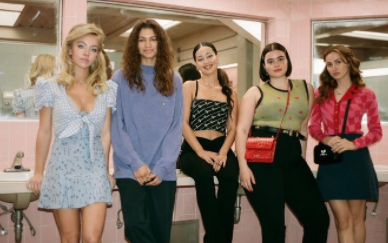Written by: Emma Pierce, Staff Writer
STYLE AND SUBSTANCE: Sam Levinson creates a show with the “emotional realism” of teen culture today.
HBO’s Euphoria takes us through the intoxicating lives of a group of high schoolers as they confront toxic relationships, identity, friendships, sexuality, trauma, and drugs, and you can take a wild guess on who the target audience is (it’s us). The hit show has amassed a sensationally large viewership, reported by several platforms including Forbes, Variety, and Collider to be HBO’s second most watched series, trailing closely behind Game of Thrones.
Popularity, especially in a digital world, comes with controversy. Euphoria’s been criticized again and again for apparently showy and unnecessary cinematography, the glorification of drug use, and an outlandish portrayal of the teenage experience. Critics have taken to the phrase “style over substance” as expressed by the Guardian. These, however, are the interpretations of forty-somethings who probably still think spilling the tea requires cleaning up after.
In an interview with Deadline, creator of Euphoria Sam Levinson establishes that the show was shot in a way that is based on the character’s emotions, not on reality, giving viewers an aesthetically pleasing yet emotionally attached watching experience. This includes visually dynamic and dialogue-free scenes with a song often by Labrinth playing, harsh spotlights, and colorful undertones depicting how we, as campy Gen Zers, live out feelings in our imaginations. Altering it stylistically to appear more realistic would mean depriving the production of its expressiveness.
Euphoria’s biggest controversy is its supposed attempt to “misguidedly glorify and erroneously depict high school student drug use”, as claimed in a statement released by “D.A.R.E”, the Drug Abuse Resistance Education. By the time I had finished season one and two, Sam Levinson made me question my next Advil.
We follow the main character, Rue, as she goes through rehab, relapse, rock bottom, and withdrawal, shattering any relationships that stand in her way and nearly killing herself. In episode five, Stand Still Like a Hummingbird, we painfully watch Rue unravel as her mom, sister, and love interest discover she’s been using. From her attempts of manipulation, escape, verbal, and physical abuse – as one who has witnessed and been affected by many episodes of this kind – Levinson authentically portrays a user and her family each overcome by her addiction, leaving a sincere impact on the audience.
In an Instagram post by Zendaya, the actress who plays Rue, she encourages watchers to realize that “If you can love her, then you can love someone that is struggling with the same thing, and maybe have a greater understanding of the pain they’re facing…”. At the end of the season two finale, Rue distinguishes that getting better for the people around her is not enough – she has to want to get better for herself above all.
We still find empathy for a flawed character, because she takes accountability and wants to be a good person. Euphoria isn’t glorifying drug addiction just because it isn’t completely vilifying the addict. The show is setting itself apart from the narrative that addicts are unworthy with misguided morals rather than people with an illness, which is nothing if not substance.
At its core, Euphoria characterizes a new generation of teenagers – it simulates our unforgiving social conditions when faced with coming of age. They may be amplified and dramaticized, but that’s just entertainment. The show acts out the nuances of our issues which come along with being a Gen Zer: Nate and Maddy’s toxicity, being stabbed in the back by a Cassie, struggling with body image like Kat, or feeling overlooked as Lexi does. Levinson approaches these in a dead-on modern context, giving Euphoria the cultural moment it deserves.

